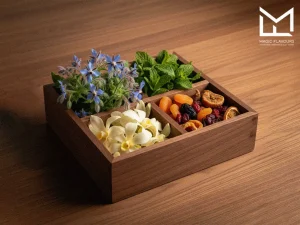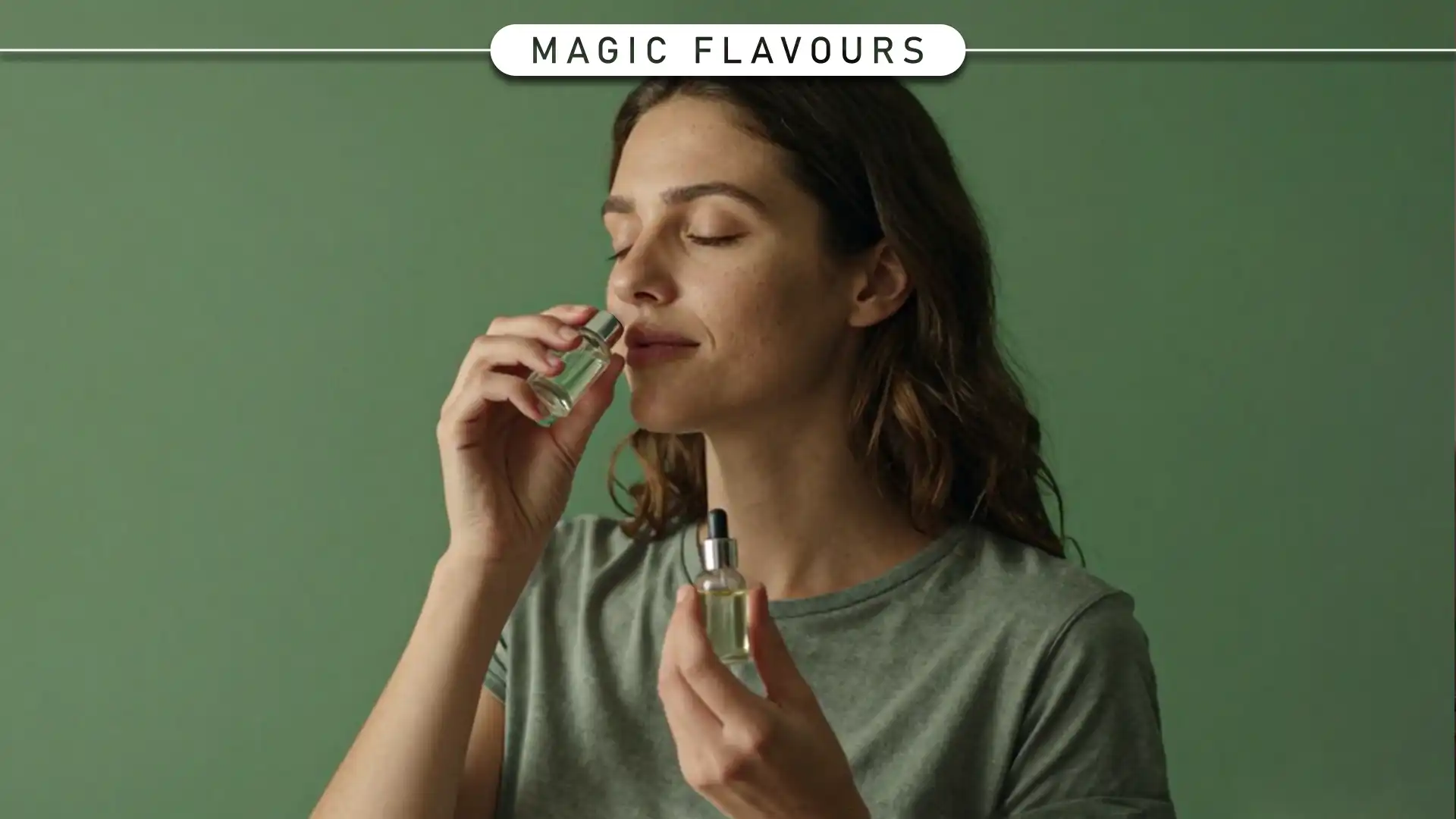Why Scent and Flavor Play a Key Role in Customer Buying Behavior
When we think about what drives customer decisions and which flavors attract more customers, we often focus on price, quality, or branding. But there’s a deeper, often underestimated layer that plays a powerful role in shaping those decisions, our senses, especially scent and taste and shows us how flavors attract more customers.
Scent and flavor influence us on a subconscious level
Before we even process a brand’s name or read a label, our brain has already made a judgment based on how something smells or tastes. That first sensory impression can create trust, trigger emotions, or even spark memories, all within seconds and attract more customers.
This is where the real challenge begins for brands across industries
While visual branding can be carefully controlled, scent and flavor are personal, emotional, and harder to standardize. A perfume that smells luxurious to one person may feel overwhelming to another. A fruity drink that tastes refreshing in one culture might come off as artificial in another. The result? Missed opportunities to connect deeply with your audience.
At the same time, brands that get scent and flavor right often create the strongest emotional bonds and can attract more customers. Think of how the smell of freshly baked bread can draw people into a café. Or how a certain minty freshness becomes the “signature” of a toothpaste brand. These aren’t coincidences, they’re examples of sensory strategy done well.
In today’s crowded market, where attention spans are short and expectations are high, scent and flavor are no longer just product features, they are powerful branding tools. They influence perception, build memory, and drive purchasing decisions more than most brands realize.
In the sections that follow, we’ll dive deeper into what makes certain scents and flavors more attractive than others, how preferences shift across cultures and industries, and what brands can do to use them more strategically, and authentically and which flavors can attract more customers.
Scents and Flavors That Captivate the Brain and attract more customers: A Scientific Perspective
It’s easy to assume that we like certain scents or flavors just because they “smell nice” or “taste good.” But in reality, our attraction to specific sensory experiences runs much deeper, all the way into how our brains is wired.
Scent is the only sense directly connected to the brain’s limbic system, the part responsible for emotions and memory. That’s why a single whiff of a particular aroma can instantly transport you back to a childhood memory, a place you once visited, or even a person you haven’t seen in years. This emotional power is something no logo or slogan can replicate.
Flavors work similarly. While they may not trigger memory as directly as scent, they are tightly linked to the brain’s reward system. Sweet, creamy, spicy, or citrusy notes activate feelings of pleasure and satisfaction. That’s why comfort foods, for instance, can have such a powerful emotional pull, they taste like safety, home, or nostalgia.
The problem?
Brands often overlook these deep sensory responses. Instead, they rely on generic trends, whatever is “hot” in the market, and forget that customers don’t just want what’s trendy. They want what feels right. A flavor that taps into a personal or cultural memory will always have more impact than something that simply checks a box on a flavor chart and can attract more customers.
So, what’s the solution?

✅ Think beyond flavor notes, think emotional connections.
Instead of just asking “What’s popular?” ask “What will make our customers feel something?”
✅ Use storytelling to frame flavor.
A vanilla note isn’t just vanilla. It could be “warm vanilla from a grandmother’s kitchen” or “chilled vanilla bean from an upscale café.” The emotional context changes how it’s received.
✅ Test with real people, not just data.
Sensory testing in real-life environments gives you richer insight into how people emotionally respond to what they taste and smell.
In short, the scents and flavors that attract the brain are those that connect to the heart. Science proves it, and successful brands embrace it, not just to please the palate, but to build lasting emotional bonds and prove that some flavors can attract more customers.
Every Industry Speaks Its Own Flavor Language: How Preferences Change Across Sectors
When it comes to scent and flavor, one size definitely doesn’t fit all. Each industry has its own emotional language, a set of expectations, associations, and sensory cues that influence how customers respond to what they smell or taste. Understanding this difference is what separates generic products from memorable ones.
Food & Beverage: can Innovative or Familiar flavors attract more customers?
In the food and drink sector, flavor must strike a delicate balance between comfort and curiosity. Consumers want products that feel trustworthy, think familiar notes like vanilla, citrus, or chocolate, but they also crave innovation when it’s done right. Unique fruits, floral accents, or spicy twists can create excitement, but only if they’re culturally relevant and not too far from what people know. Go too far, and you risk confusion or rejection. Stay too safe, and you disappear in the noise.
✅ Solution: Pair one adventurous note with one familiar one. Think passionfruit-lime, saffron-vanilla, or hibiscus-honey. Let innovation meet comfort halfway. these flavors can attract more customers.
Cosmetics & Personal Care: Scents That Signal Clean, Safe, and Luxurious can attract more customers
In this industry, scent is deeply emotional. It’s not just about smelling good, it’s about feeling clean, confident, pampered. A lotion that smells too strong can feel synthetic or overwhelming. A shampoo that lacks scent might feel “cheap” or ineffective. And perceptions vary: a clean scent in Japan might lean fresh and watery, while in the Middle East it could include musk and floral notes.
✅ Solution: Match the scent to the product promise. For “hydration,” use fresh florals or aloe notes. For “anti-aging,” think warm amber or soft rose. Subtlety is power here.
Perfumery: The Art of Emotional Storytelling Through Notes

In fine fragrance, scent becomes a journey. Top notes (first impression), heart notes (core experience), and base notes (long-lasting memory) must all be in harmony. This is the most emotional and identity-driven category — where customers are looking for something that feels like them. A mismatch in notes, or too much reliance on trends, can make a perfume feel forgettable.
✅ Solution: Focus on narrative. What story is the scent telling? Use layering wisely. And always test with your target demographic, not just internal noses.
Tobacco & Shisha: Bold Combinations for a New Generation can attract more customers
In the world of shisha and tobacco flavors, users aren’t just smoking, they’re experiencing. Flavors are about mood, identity, and expression. Younger consumers often seek bold, fruity, or dessert-inspired blends, while older users might prefer classics like mint or apple. The challenge is in creating balance: bold enough to excite, but smooth enough to enjoy.
✅ Solution: Innovate with caution. Pair trendy flavors (e.g. blueberry mojito, candy grape) with stable foundations like mint, citrus, or spice to ensure broad appeal.
Air Care & Ambience: Fragrances That Shape Environments
Whether it’s a hotel lobby, a retail store, or a home diffuser, environmental scents are about managing space and mood. These fragrances must feel welcoming, clean, and brand-aligned, without being intrusive. The challenge is often technical too: scents must diffuse well, linger appropriately, and perform consistently across different room sizes or climates.
✅ Solution: Think of scent as a branding tool. A relaxing lavender-cedar blend might work for a spa, while citrus-mint fits a gym. Design the scent with the space and the emotion in mind.
No matter the sector, successful flavor and scent design starts with empathy, understanding how your customers want to feel when using your product. Because at the end of the day, people don’t just remember what they smelled or tasted — they remember how it made them feel.
The Scents and Flavors That Truly Attract Customers (With Examples)

It’s no secret: certain scents and flavors consistently outperform others when it comes to customer attraction. While taste is subjective, some sensory notes have an almost universal emotional pull, making them powerful tools for product development across industries.
Timeless Favorites: The Global Appeal of Familiar Notes
Across cultures and categories, a few key players show up again and again:
- Vanilla – Comforting, warm, and nostalgic. Found in everything from desserts to perfumes and body lotions. It signals safety and indulgence.
- Mint – Crisp, clean, and energizing. Widely used in oral care, beverages, shisha, and air fresheners. It often communicates “freshness” and “coolness.”
- Citrus – Think lemon, orange, bergamot. Bright, zesty, and uplifting. These notes boost mood and are widely loved in beverages, cleaning products, skincare, and even tobacco.
- Sandalwood – Creamy, woody, and grounding. Popular in fine fragrance, incense, and luxury cosmetics. It adds a sense of calm and sophistication.
What makes these notes so effective? They tap into universal emotional associations: trust, energy, purity, comfort, and warmth, feelings customers are drawn to, often subconsciously.
Recent Trends in Flavor & Fragrance Development
In the past few years, the flavor and fragrance industries have evolved rapidly. Customer expectations are shifting toward experiential, functional, and globally inspired sensory profiles and there are some reason to show us some flavors can really attract more customers.
Here are a few standout trends:
- “Wellness” Scents & Flavors: Think eucalyptus, lavender, matcha, or elderflower. Customers want to feel good, not just smell or taste something nice.
- Unique & Regional Inspirations: Flavors like lychee, saffron, cardamom, or yuzu bring a sense of travel and luxury to everyday products.
- Gourmand Notes: Dessert-like flavors (caramel, praline, coffee, baked apple) are on the rise, especially in shisha, perfume, and skincare.
- Smoky, Earthy, or Botanical Profiles: Notes like vetiver, pine, smoked vanilla, and patchouli are helping brands tap into a “natural but bold” aesthetic.
These trends aren’t random, they reflect a deeper emotional shift: people want products that tell stories, evoke memories, and reflect their identity.
Brands That Got It Right: Flavors That Made the Difference
Let’s look at a few real-world examples of how one signature flavor or scent helped elevate a brand:
The Body Shop’s White Musk – This iconic fragrance became the brand’s identity. Clean, soft, and sensual, it appealed to multiple generations and helped define cruelty-free perfumery.
- Ben & Jerry’s Cherry Garcia – A unique flavor that stood out from standard ice creams. Its quirky name and bold taste became a cult favorite.
-
Fanta’s Unique Limited Editions – Rotating fruit flavors like mango, lychee, or passionfruit helped the brand stay exciting and relevant across different regions.
Shisha brands using Blueberry Mint – This now-classic combination wasn’t always obvious. But its balance of sweetness and freshness made it a go-to for younger audiences, especially in the Middle East.
The takeaway?
- Customers are drawn to what makes them feel something.
Familiar notes bring comfort. unique ones offer excitement. Smart brands know how to balance both. - Choosing the right flavor or scent can define your product’s success.
It’s not just a detail, it’s a strategy.
The Psychology of Names and Colors in Flavors and Scents

Have you ever wondered why sometimes the name of a flavor or scent feels even sweeter or more appealing than the actual taste or aroma? It’s not just in your head, there’s real psychology behind how names and colors influence our perception.
Why the Name Can Be Sweeter Than the Scent Itself
Names carry stories, emotions, and expectations. When you hear a flavor called “Velvet Vanilla” or a fragrance named “Morning Breeze,” your brain instantly begins crafting a sensory experience before you even taste or smell anything. This mental setup can enhance the perceived quality and enjoyment of the product.
In fact, research shows that people’s expectations shape their sensory experiences more than the actual stimulus sometimes. So, a carefully chosen name can make a flavor feel richer, more luxurious, or more exciting, even if the actual ingredients are similar to something else.
The Role of Color in Flavor and Scent Perception
Color doesn’t just affect how a product looks, it deeply influences how we perceive taste and aroma. For example:
Warm colors like reds and oranges often suggest sweetness or spiciness.
Cool colors like blues and greens can signal freshness or mintiness.
Neutral or earthy tones might imply naturalness or mildness.
This means that the packaging color, the color of the flavor itself, and even marketing visuals play a huge role in setting expectations and guiding customer preferences.
The Power of Imagery in Naming Flavors and Scents
When naming a flavor or scent, brands that tap into vivid mental images win. Names that evoke textures, places, moods, or memories create a stronger emotional connection. For instance:
“Sun-Kissed Citrus” brings to mind warm sunshine and freshness.
“Whispering Woods” suggests mystery and natural calm.
“Honeyed Amber” feels warm, sweet, and inviting.
This imagery helps customers imagine the experience, making the product more desirable before they even try it.
In summary:
- The name and color of a flavor or scent shape customer expectations and experiences more than you might think.
- Thoughtful naming and color choices can turn an ordinary product into an emotional, sensory journey.
- This is why successful brands invest heavily in naming and design, because these elements speak directly to the subconscious mind.
Regional and Cultural Flavors: One Global Taste Does Not Fit All
When it comes to flavors and scents, a “one-size-fits-all” approach simply doesn’t work. What excites taste buds in one region might feel unfamiliar or even off-putting in another. Understanding these cultural and regional differences is essential for creating products that truly resonate.
Popular Flavors Across Different Regions
- Middle East: Rich, bold, and often aromatic. Flavors like pomegranate, rose, cardamom, and dates are deeply embedded in local tastes. People in this region appreciate complex blends that combine sweetness with spice.
- Asia: A diverse palette ranging from the umami and spicy notes of Southeast Asia to the subtle floral and green tea flavors of East Asia. Ingredients like yuzu, matcha, lychee, and ginger are very popular.
- Europe: Often favors more classic and subtle flavors. Vanilla, berry, chocolate, and herbal notes are well-loved. There is also a growing trend toward natural, organic, and artisanal flavors.
- America: Bold and innovative tastes dominate. From the sweet and smoky barbecue notes to tropical fruit blends and spicy cinnamon, American consumers often seek exciting and new experiences.
Localizing Flavors for Target Markets
Simply translating or exporting a popular flavor from one region to another rarely works. Successful brands take the time to:
- Research local taste preferences and cultural meanings attached to ingredients.
- Adapt formulations to match texture, sweetness level, and intensity favored by the market.
- Test extensively with local consumers before launching.
- This localization not only improves acceptance but also builds emotional connections and brand loyalty.
Examples of Success and Failure in Regional Flavor Adaptation
Success: A European chocolate brand introducing a saffron-infused line specifically for Middle Eastern markets saw a huge boost because it married familiar luxury with regional appeal.
Failure: A North American beverage company launching a strong mint flavor in East Asia faced poor sales because the flavor was perceived as too overpowering and unfamiliar for local preferences.
In short:
- Recognizing that flavor preferences vary widely across cultures is crucial.
- Thoughtful localization of scents and tastes can turn products into regional favorites.
- Ignoring these differences often leads to missed opportunities or product failures.
From Testing to Production: How to Create a Flavor That Truly Attracts Customers
Creating a flavor that resonates with customers is more than just mixing ingredients, it’s a delicate science and art that requires careful testing and collaboration to attract more customers.
The Importance of Sensory Testing
Sensory testing is the backbone of flavor development. It involves evaluating a product through human senses, taste, smell, and sometimes touch, to understand how customers will experience it. Without these tests, companies risk launching flavors that don’t connect or even repel their audience.
This process helps identify what works, what needs improvement, and what might be missing. By gathering detailed feedback from a diverse panel, brands can fine-tune their recipes to perfection.
Leveraging Data and Customer Feedback
Data-driven decisions are essential in today’s competitive market. Beyond sensory panels, real customer feedback, whether from surveys, social media, or focus groups, provides invaluable insights.
Analyzing this data helps brands spot trends, preferences, and pain points. It also guides future iterations of the flavor to ensure it stays relevant and loved.
Collaboration with Psychologists, Fragrance Designers, and Flavor Experts
Flavor creation isn’t just a chemical or culinary task, it’s deeply psychological. Collaborating with psychologists helps brands understand how customers perceive and emotionally respond to different flavors and scents.
Fragrance designers bring expertise in layering aromas to create memorable, lasting impressions. Flavor experts combine science and creativity to balance tastes and textures perfectly.
Together, these experts ensure the final product is not just a flavor but an experience that captivates and keeps customers coming back and prove that some flavors can attract more customers.
In summary:
- Sensory testing is crucial for crafting flavors that genuinely appeal.
- Customer data and feedback guide continual improvement and relevance.
- Interdisciplinary collaboration transforms flavors from simple mixtures into unforgettable experiences.
Conclusion: The Blend of Creativity, Market Insight, and Quality

In today’s competitive world of flavored tobacco and hookah products, the future belongs to those who can skillfully combine creativity, deep market understanding, and uncompromising quality.
Flavors are no longer just ingredients, they are storytelling tools that define a brand’s identity and connect emotionally with consumers. Success lies in daring to innovate while staying rooted in what customers truly want and expect.
Embracing calculated risks in flavor development can unlock new markets and captivate the ever-evolving tastes of younger, more adventurous consumers. It’s about balancing art and science, intuition and data, tradition and novelty.
Let this be a call to all innovators and brands:
- Be bold in your flavor experiments.
- Listen closely to your customers and adapt.
- Never compromise on quality.
The most memorable and successful flavors are born where creativity meets market insight, and that’s where your next big opportunity lies. now we know some flavors can attract more customers.
